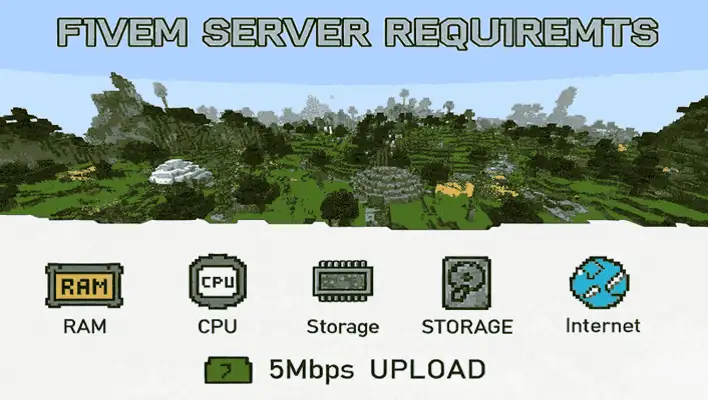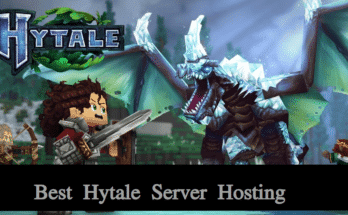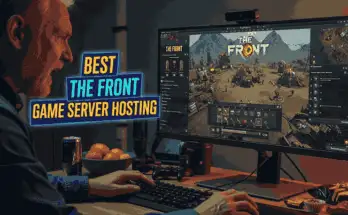Running a smooth and immersive GTA V roleplay experience takes more than just great scripts and mods—it starts with understanding the FiveM server requirements that power it all. Whether you’re managing a small friends-only RP server or scaling up for a large public community, the performance of your server directly affects everything from frame stability and voice sync to mod responsiveness and player retention.
FiveM is far more demanding than vanilla GTA Online. With dozens of real-time scripts, custom vehicles, voice chat, and map assets all running simultaneously, your server’s CPU, RAM, storage, and network must be finely tuned. Underpowered setups can quickly lead to lag spikes, crashes, and frustrating desyncs, killing immersion for players in the middle of a police chase or business deal.
In this guide, we will break down the key FiveM server requirements, explain how each component impacts gameplay, and help you choose the right specs for the experience you want to deliver.
💡 Want to skip the server setup stress? We recommend GravelHost — one of the most trusted names in game server hosting. With blazing-fast NVMe SSDs, high-performance CPUs, and worldwide data centers, GravelHost is ready to handle everything FiveM throws at your server.
Table of Contents
Quick Answer: What Are the FiveM Server Requirements?
To host a FiveM server smoothly, you’ll need at least a quad-core CPU @ 3.5 GHz, 8 GB of RAM, and SSD or NVMe storage. For large RP or modded servers, a 6–12 core CPU, 16–24 GB RAM, and 50+ GB of NVMe SSD storage are recommended. Bandwidth is also crucial—aim for 30–50 Mbps upload speed to ensure lag-free multiplayer gameplay.
CPU Requirements for FiveM Servers
The CPU is the core of your FiveM server’s performance. It handles real-time tasks like player movement, vehicle physics, NPC AI, mod logic (like ESX or QBCore), and all the backend scripting that makes your RP server dynamic and alive. Unlike many modern games, FiveM is highly dependent on single-thread performance, meaning clock speed matters more than just having many cores.
If your server doesn’t have enough processing power, expect:
Delays in player sync and animations
Lag when entering crowded areas
Script execution hiccups
Rubberbanding during vehicle movement or combat
What Impacts CPU Load?
Number of connected players
Active mods and frameworks (e.g., ESX, QBCore)
Frequency of events (robberies, AI routines, car spawns)
Database calls and backend logic
Running 50 players with vanilla FiveM is not the same as hosting 20 with heavy modding and custom scripts.
Recommended CPU Specs for FiveM Servers
| Server Size | Player Count | Minimum CPU | Recommended CPU |
|---|---|---|---|
| Solo/Dev Testing | 1 | Dual-core @ 3.0 GHz | Quad-core @ 3.5+ GHz |
| Small Public Server | 5–15 | Quad-core @ 3.5+ GHz | 6-core @ 3.8+ GHz |
| Medium RP Server | 15–30 | 6-core @ 3.8 GHz | 8-core @ 4.0+ GHz |
| Large/Modded Server | 30–64+ | 8-core @ 4.0+ GHz | 12-core @ 4.2+ GHz |
💡 Tip: Prioritize CPUs with high single-core performance, such as AMD Ryzen 9 or Intel i9 processors, to avoid bottlenecks on script-heavy servers.
RAM Requirements for FiveM Servers
RAM is your server’s short-term memory. It holds live player data, active scripts, world states, inventories, AI routines, map assets, and more, all while allowing the game to run without interruption. As your FiveM server grows in players, vehicles, and mods, so does its demand for RAM.
If you don’t have enough RAM, you’ll start to notice:
Slow loading times for players
Server-side lag when switching regions or using custom scripts
Crashes or memory leaks from mod-heavy environments
Inconsistent performance during peak activity (e.g., police pursuits, heist events)
What Consumes the Most RAM?
Number of active players and NPCs
Custom maps, vehicles, and skins
Mod frameworks like ESX, QBCore, and housing systems
Voice systems like Mumble VoIP
Real-time events (jobs, robberies, menu UIs, etc.)
FiveM modded servers, especially RP-based ones, can easily eat through 12–16 GB of memory or more, depending on complexity.
Recommended RAM for FiveM Server Types
| Server Type | Player Count | Minimum RAM | Recommended RAM |
|---|---|---|---|
| Solo Testing / Dev | 1 | 2 GB | 4 GB |
| Small Public Server | 5–15 | 4 GB | 6–8 GB |
| Medium RP Server | 15–30 | 8 GB | 12–16 GB |
| Large Modded Server | 30–64+ | 16 GB | 24+ GB |
💡 Note: If you’re using custom maps and large resource packs, always plan 20–30% more memory than your average usage.
Storage Requirements for FiveM Servers
While CPU and RAM handle live performance, storage determines how fast your server loads resources, maps, and mods. In FiveM, especially with custom RP environments, players rely on your server to serve dozens (or even hundreds) of files, including vehicles, skins, buildings, sound packs, and more.
Using a traditional HDD can cause slow loading, stuttering, and lag when syncing resources. That’s why fast SSD or NVMe storage is critical to a smooth FiveM experience.
What Impacts Storage Usage?
Custom maps (Los Santos reworks, interiors, MLOs)
Player skins and clothing packs
Custom vehicles and tuning mods
Add-on scripts and plugins
Server logs, backups, and MySQL database files
If your server uses a modded framework like QBCore or ESX, expect storage usage to grow fast, especially with frequent updates and backup snapshots.
Recommended Storage for FiveM Servers
| Server Type | Mod Level | Storage Type | Recommended Space |
|---|---|---|---|
| Basic Public Server | Light mods | SSD | 10–15 GB |
| Medium RP Server | Moderate mods | SSD/NVMe | 20–40 GB |
| Heavily Modded Server | High mods/maps | NVMe SSD | 50–100 GB+ |
💡 Tip: NVMe SSDs offer up to 6x faster read/write speeds than standard SATA SSDs—reducing asset load times and preventing sync lag.
Network and Bandwidth Requirements for FiveM Servers
Your FiveM server might have the best CPU, RAM, and storage, but without a fast and stable network connection, players will experience rubberbanding, voice chat issues, or disconnects. Since FiveM handles real-time player actions, VoIP traffic, and custom resource streaming, bandwidth is a critical part of hosting a reliable multiplayer experience.
If your network isn’t strong enough, even the best server hardware won’t stop:
Lag during peak hours
Delays in loading custom content
Broken voice communication
Player desync during events or chases
What Affects Network Performance?
Number of simultaneous players
Size of streamed assets (cars, maps, textures)
Frequency of server-client events (e.g., combat, job triggers)
Real-time VoIP data (like Mumble or TeamSpeak plugins)
Even a small RP server with 5–10 players can use several Mbps constantly—larger modded servers need far more.
Recommended Bandwidth for FiveM Hosting
| Player Count | Minimum Upload Speed | Recommended Upload Speed |
|---|---|---|
| 1–5 Players | 5 Mbps | 10 Mbps |
| 6–15 Players | 10 Mbps | 20 Mbps |
| 16–32 Players | 20 Mbps | 30–40 Mbps |
| 32+ Players | 30 Mbps | 50+ Mbps |
⚠️ Warning: Hosting on a home network is not ideal due to dynamic IPs, ISP throttling, and NAT issues.
FiveM Server Requirements at a Glance
Need a quick overview of what it takes to host a smooth and stable FiveM server? Use this table to compare the minimum and recommended hardware specs by server size and use case—perfect for both new server owners and experienced RP admins.
| Server Type | Player Count | CPU (Min / Rec.) | RAM (Min / Rec.) | Storage Type | Storage Size | Upload Speed | Recommended Hosting Plan |
|---|---|---|---|---|---|---|---|
| Solo Testing / Dev | 1 | Dual-core @ 3.0 / Quad-core @ 3.5 GHz | 2 GB / 4 GB | SSD | 5–10 GB | 5 Mbps | GravelHost 2–4 GB Plan |
| Small Public Server | 5–15 | Quad-core @ 3.5 / 6-core @ 3.8 GHz | 4 GB / 8 GB | SSD/NVMe | 10–20 GB | 10–20 Mbps | GravelHost 6–8 GB Plan |
| Medium RP Server | 15–30 | 6-core @ 3.8 / 8-core @ 4.0+ GHz | 8 GB / 16 GB | NVMe SSD | 30–50 GB | 20–30 Mbps | GravelHost 12–16 GB Plan |
| Large Modded Server | 30–64+ | 8-core @ 4.0+ / 12-core @ 4.2+ GHz | 16 GB / 24+ GB | NVMe SSD | 50–100+ GB | 40–50+ Mbps | GravelHost High-Performance VPS |
🧠 Tip: Always choose slightly more RAM and storage than you think you’ll need. Framework updates, player growth, and mod additions can spike usage unexpectedly.
Conclusion: Launch Your FiveM RP Server with Confidence
Running a successful FiveM server isn’t just about creative scripts and immersive RP—it’s about having the hardware to back it all up. From high-speed CPUs to low-latency bandwidth, every piece of your setup directly impacts how smooth, stable, and enjoyable the experience is for your players.
To recap:
CPU is critical for script execution and syncing gameplay logic
RAM ensures your mods, players, and events run without lag
Storage (preferably NVMe SSD) keeps load times lightning fast
Network bandwidth keeps your players connected and in sync
If you’re just testing the waters, start small, but if you’re serious about growing a roleplay community, invest in the right specs from the start.
💡 Want to skip the server headaches entirely? GravelHost delivers FiveM hosting optimized for modded RP, with NVMe SSDs, high-performance CPUs, global data centers, and 24/7 support—so you can focus on storytelling, not server crashes.
FAQs About FiveM Server Requirements
Yes, technically you can, but it’s not recommended. Home networks often lack static IPs, proper port forwarding, and consistent bandwidth. You’ll also need to run your PC 24/7. For serious hosting, a dedicated provider like GravelHost ensures better uptime, performance, and security. To run a dedicated FiveM server smoothly, you should have at least a quad-core CPU @ 3.5 GHz, 8 GB of RAM, and NVMe SSD storage. For larger or mod-heavy servers, bump that to a 6–12 core CPU, 16–24 GB RAM, and 50+ GB of fast SSD space. Modded RP servers using frameworks like QBCore or ESX should start with 12–16 GB of RAM, especially if you expect 20+ players and use custom maps, jobs, vehicles, or interiors. 1. Can I host a FiveM server on my home PC?
2. What are the FiveM dedicated server requirements?
3. How much RAM do I need for a modded FiveM RP server?




